Key takeaways:
- Choosing the right front-end framework is crucial and should align with project goals and requirements.
- Frameworks enhance collaboration and community support significantly benefits developers during challenges.
- A strong foundation in core web development concepts like HTML, CSS, and JavaScript is essential for effectively using any framework.
- Iterative development and seeking feedback early can greatly improve the development process and final outcomes.
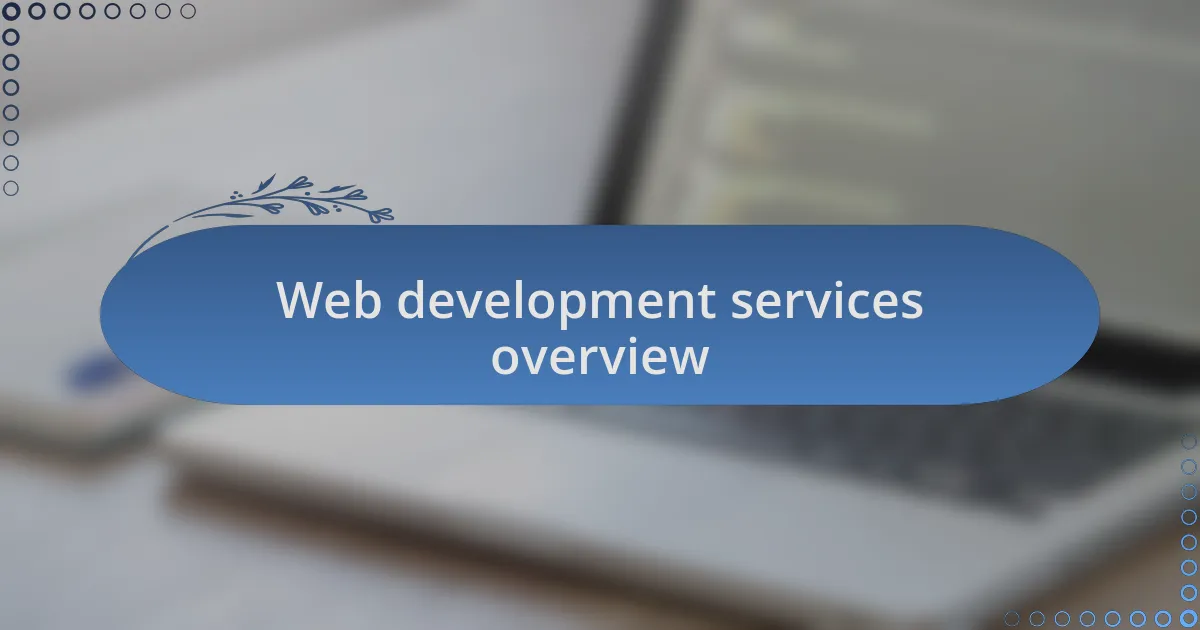
Web development services overview
Web development services encompass a wide range of offerings that are essential for building and maintaining a robust online presence. I remember when I first started my journey in web development, the complexity of these services was daunting. From front-end visual design to back-end server management, each aspect plays a critical role in ensuring that a website functions smoothly and meets the needs of its users.
One vital aspect of web development is the choice of frameworks and tools to enhance productivity and performance. Have you ever been overwhelmed by the number of options available? I certainly was. Experimenting with different front-end frameworks taught me that the right tools can make a significant difference in creating responsive designs that engage users and provide a seamless experience.
Another critical service in web development is ongoing site maintenance and optimization. I’ve seen firsthand how a neglected website can lead to poor user experiences and high bounce rates. This realization drove home the importance of regularly updating content, fixing broken links, and ensuring that all elements work together to create a cohesive user experience. It’s about more than just launching a site; it’s about nurturing it to thrive over time.
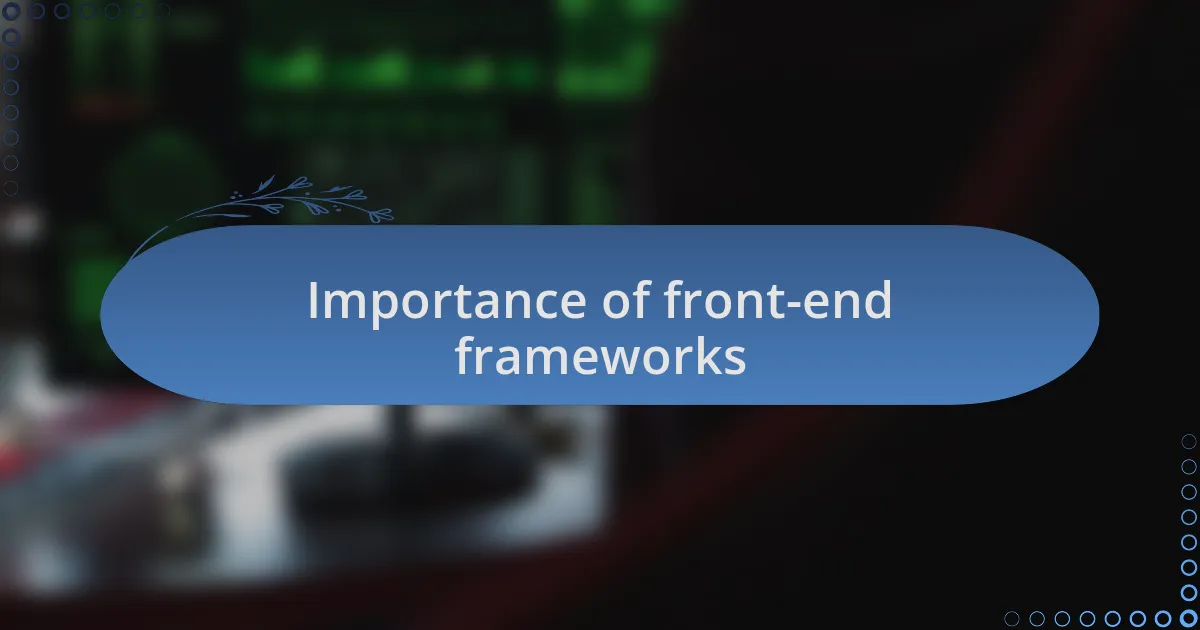
Importance of front-end frameworks
When I first dived into using front-end frameworks, the difference was immediate. These frameworks streamline the development process, letting me focus on design and functionality without getting lost in the minutiae of coding. Have you ever wished you could create stunning interfaces with less hassle? That’s what frameworks like React or Vue offer—a faster path to turning ideas into reality.
Another aspect I’ve come to appreciate is how front-end frameworks enhance collaboration. Working on a team project, I noticed that using a common framework laid a solid foundation for everyone involved. It was like sharing a language; suddenly, we could communicate more effectively about the code we were writing. This uniformity not only boosted our productivity, but it also reduced the likelihood of errors—something every developer fears.
Moreover, I find that frameworks often come with a vibrant community and an arsenal of resources. The first time I hit a roadblock on a project, I turned to an online forum dedicated to my chosen framework. I was amazed by the wealth of knowledge and support available at my fingertips. It reinforced the idea that when you choose a framework, you’re not just selecting a tool; you’re joining a community that helps you grow as a developer.
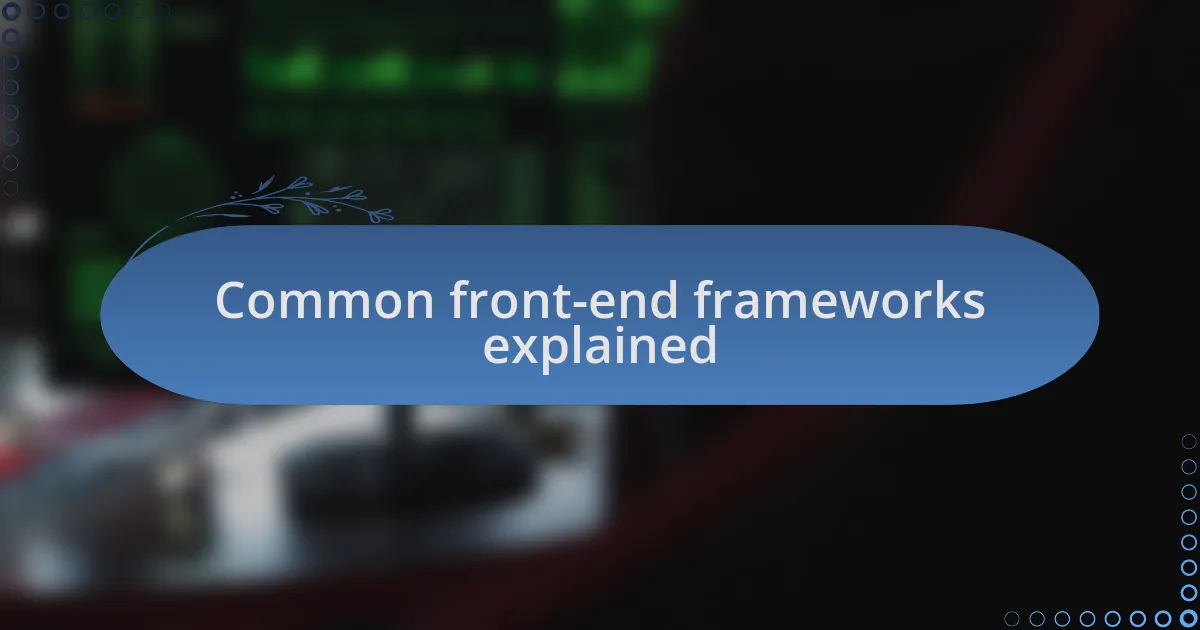
Common front-end frameworks explained
Common front-end frameworks are essential tools in modern web development, each bringing its own strengths to the table. For example, React, developed by Facebook, excels in creating dynamic user interfaces and allows for the efficient rendering of large datasets. I remember grappling with a project that required seamless updates without page reloads—React made it feel effortless, really transforming the user experience.
On the other hand, Vue offers a more approachable learning curve, especially for those just starting out. I vividly recall my first foray into Vue; it felt like diving into a welcoming community rather than a daunting framework. The flexibility of Vue’s templating syntax allowed me to build a complex interface much faster than I had anticipated, and it made me appreciate how a friendly framework can boost confidence in budding developers.
Then there’s Angular, which stands out for its comprehensive structure and robust tools. I once worked on a large-scale application that required intricate routing and data management. Angular’s built-in features simplified those challenges immensely. I couldn’t help but think—how enriching it is to work with a framework that not only provides the tools but also encourages best practices through its architecture! Each framework has its place, and understanding their unique capabilities has greatly enhanced my web development journey.
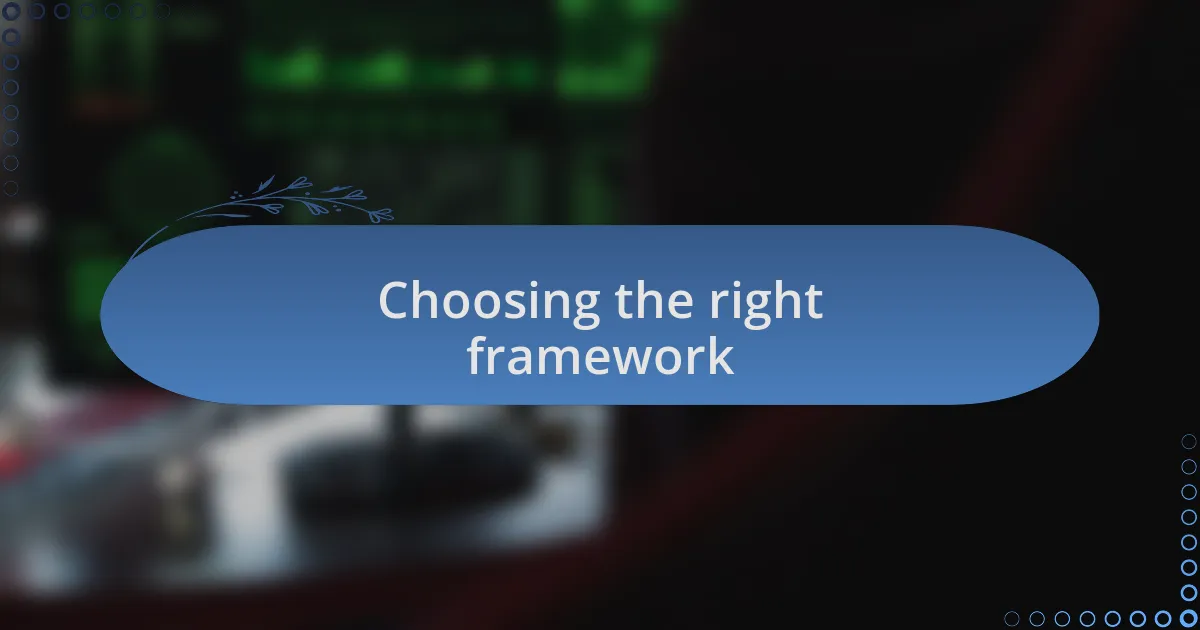
Choosing the right framework
Selecting the right front-end framework is pivotal to the success of any project. I often ask myself, “What do I need to achieve with this application?” For instance, if rapid development is my priority, I lean towards frameworks like Vue, which let me prototype ideas quickly. But when I need a more complex solution with heavy data processing, React usually becomes my go-to choice.
I recall a project where the client demanded frequent updates to their website without compromising performance. That’s when I realized how vital it is to align the framework choice with specific project requirements. Choosing poorly can lead to unnecessary complications and frustration, forcing me to backtrack and reevaluate everything. This experience reinforced my belief that understanding the project scope should drive the framework decision.
Moreover, community support can’t be overlooked. I remember feeling lost while learning a new framework, but a vibrant community can provide the guidance I need. Questions arise, and having a platform to turn to or resources like documentation makes the difference between sticking with a challenge or moving forward with confidence. Don’t forget—your choice is not just about what’s trendy; it’s about finding a framework that resonates with your development style and project goals.
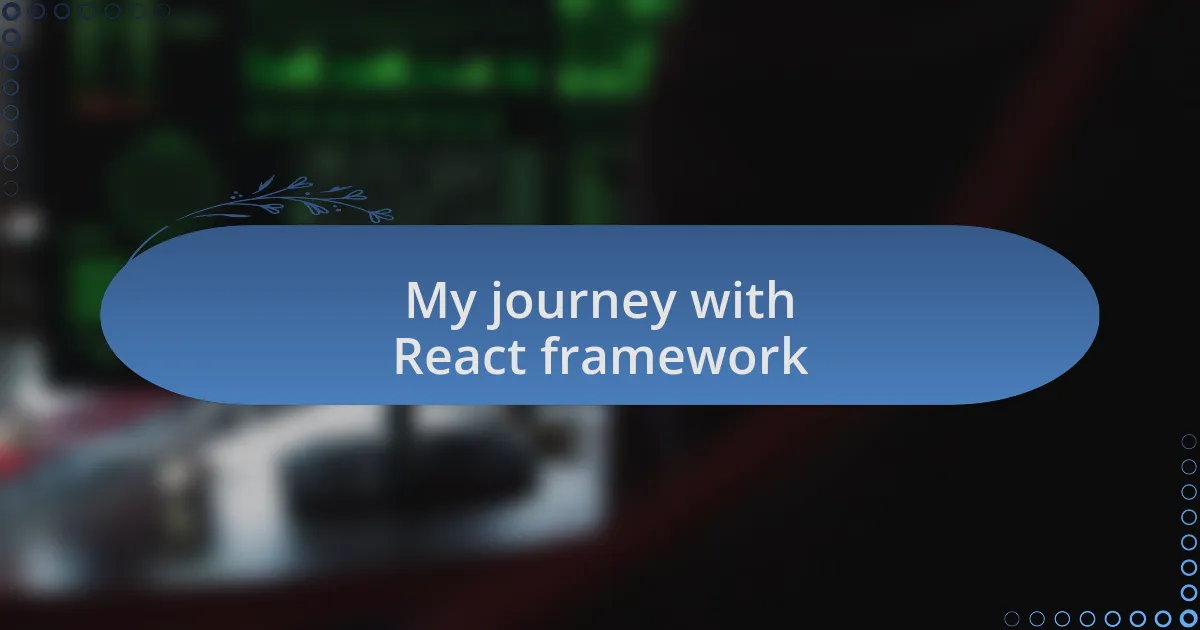
My journey with React framework
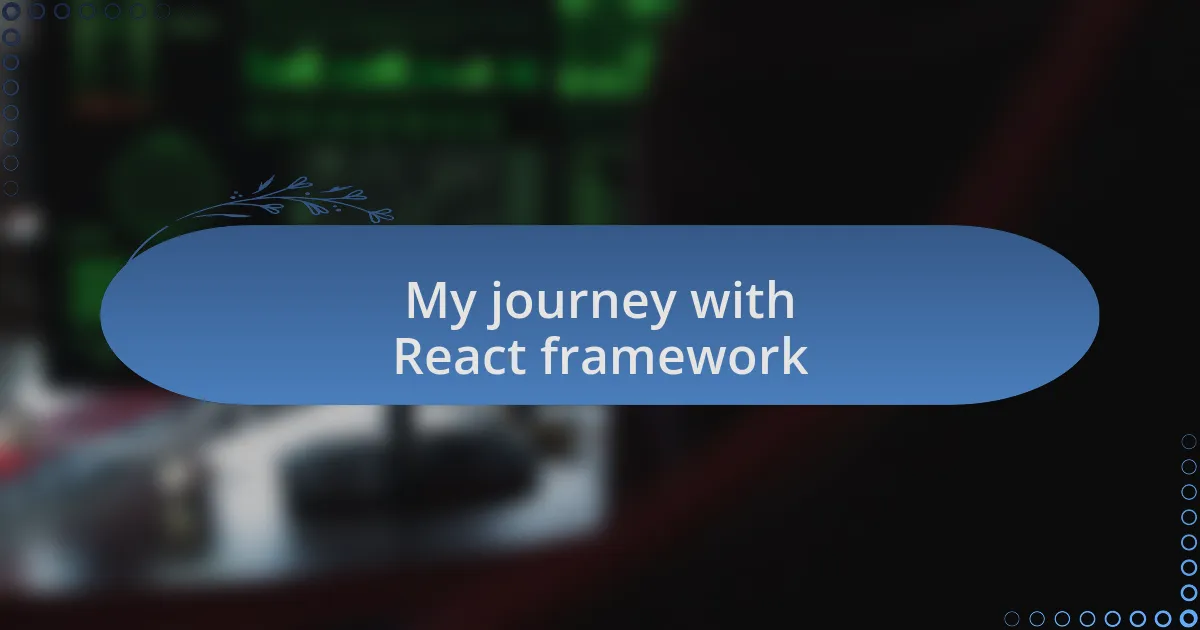
My journey with React framework
I first dove into React during a fast-paced startup project. As the team lead, I was overwhelmed yet excited—how could a framework that encourages component-based architecture simplify our workflow? It wasn’t long before I fell in love with its ability to manage state effectively, which made handling user interactions feel seamless. I often found myself pondering, “How did I develop without this?” It was a game-changer for my development approach.
As I developed multiple applications with React, I encountered challenges, especially with JSX syntax. Initially, it felt foreign; I even wondered if I had taken the right path. However, once I embraced the quirks, I realized that those moments of frustration often transformed into opportunities for deeper learning. It taught me that discomfort is a part of growth, particularly with something as powerful as React.
Reflecting on my experiences, I can say that one of the most enriching aspects of using React has been the sheer joy of reusability. I remember the satisfaction of creating a component that could be reused across various projects. Each time I plugged it into a different application, it felt like rediscovering a favorite recipe and savoring the nostalgia it brought. Isn’t it rewarding when your work echoes back in new forms? React has uniquely shaped my journey, making me a more efficient and innovative developer in ways I had never expected.

Challenges I faced with frameworks
When navigating the world of front-end frameworks, I quickly realized that each came with its unique set of challenges. For instance, while integrating React with older codebases, I often found myself grappling with compatibility issues that slowed down progress. Has anyone else faced that frustrating moment when you know the solution is just out of reach? I certainly have, and it forced me to adapt my problem-solving strategies and often involve deeper dives into documentation.
Another hurdle I encountered was performance optimization. Initially, I was surprised by how a seemingly straightforward application could become sluggish as I added more components. I vividly remember one late-night debugging session when I learned about the importance of memoization. The concept was daunting, but the relief of having a snappy application afterward was worth every ounce of confusion I faced. Isn’t it astonishing how a little extra knowledge can completely change the user experience?
Finally, I often struggled with keeping up with frequent updates and changing best practices. Just when I felt comfortable with the framework, a new version would roll out, and I would be back in the learning curve. It’s a bit like trying to stay ahead in a fast-paced race—how do you ensure that you’re not just running but also running in the right direction? Each update required me to rethink my approach, but in retrospect, it has made me more resilient and adaptable in this ever-evolving landscape of web development.

Lessons learned from my experience
One of the most valuable lessons I’ve learned is the importance of focusing on the fundamentals of web development. Early on, I got so caught up in the intricacies of various frameworks that I neglected core concepts like HTML, CSS, and JavaScript. I remember an eye-opening moment when a simple lack of understanding led to hours of debugging that could have been avoided. It made me realize that a strong foundation not only enhances my skills but also gives me the confidence to tackle any framework.
I also discovered the significance of community support and resources. In a situation where I was stuck with a particularly stubborn bug in Vue.js, a quick search led me to a forum where someone had faced the same problem. Their solution not only helped me but also reinforced the idea that I’m not alone in this journey. Why struggle in silence when there’s a wealth of knowledge out there? Engaging with the community can often turn a frustrating moment into a learning opportunity, making the process more enjoyable.
Finally, I learned that iteration is key. When I first built my projects, I’d spend too much time trying to make everything perfect before seeking feedback. My turning point came when I shared a rough version of my app with friends and received constructive criticism. Their insights were invaluable and taught me that it’s okay to embrace imperfection. It made me realize that developing an application is much like a conversation; the more you share and refine, the better the outcome will be.